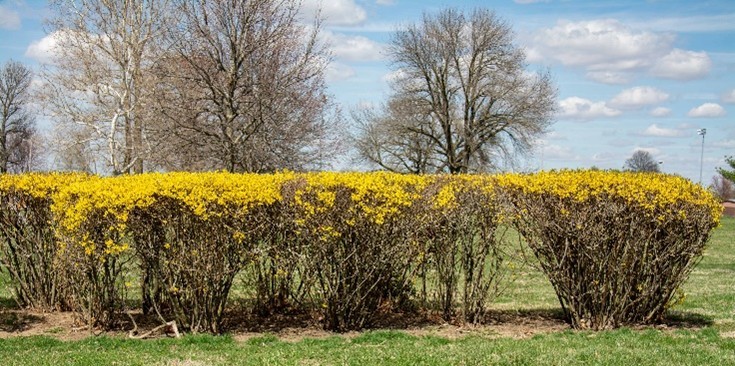Help! My forsythia isn’t blooming like it used to

JACKSONVILLE, Ill. — Forsythias are planted for their stunning floral display in early spring. Have you ever seen a forsythia bush and, for some reason, maybe there are only blooms at the very top and the sides are barren of flowers, or maybe wondered why it didn’t bloom at all? There are several different reasons as to why this could be happening.
When do shrubs (or trees) produce their flower buds?
Shrubs are typically classified into three different bloom times: spring, summer, and fall. When they bloom will dictate when the best time to prune them is, if we want to preserve flower buds. Forsythia and other spring-blooming shrubs like lilacs and vernal witch hazel start developing flower buds the previous year, meaning they bloom on old wood.
Why isn’t my forsythia blooming well?
In many cases, the most likely cause is the plants were improperly pruned. Since they bloom on old wood, if they are pruned in the fall or winter, the flower buds will be removed. The best time to prune forsythia, and other spring-blooming trees and shrubs is shortly after they are done blooming in the spring.
Forsythias will produce upright or arching branches and have a rounded upright growth habit, and can get quite large, up to 8 to 10 feet tall and 10 to 12 feet across. However, they are commonly pruned as a hedge. This formal, compact box-like appearance goes against the natural form of the plants. Maintaining forsythia as a hedge will require pruning later in the season, and therefore removing flower buds. If space is an issue, there are smaller cultivars such as Fiesta (3-4 feet tall and wide) and Show Off Sugar Baby (1.5-2.5 feet tall and 2-3 feet wide).
Forsythia will bloom best if they are regularly pruned. Once plants have established, prune out a third to a quarter of the oldest stems at ground level every other year (thinning). This will help promote new, vigorous growth. If plants have been neglected or have become overgrown, they can be rejuvenated by being cut back to within a few inches of the ground in the winter. The plants will then send out new growth, but it may take a year or two for them to bloom.
Another reason forsythias may not bloom well is lack of sunlight. Look at the plants surrounding the forsythia: were they planted near a tree that has now grown large enough to shade them? For the best floral display, forsythias need full sun exposure. The less light they get, the fewer blooms they will produce.
Cold weather can also affect the floral display of forsythias. While forsythia plants, for the most part, are hardy to zone 4 or 5, the flower buds may not be as hardy. When temperatures drop below minus-10 degrees, flower buds may be killed or damaged in many cultivars. Fortunately, there are cultivars, such as Meadowlark, Northern Gold and Northern Sun, which have flower buds that are hardy down to minus-30 degrees.
Miss Clipping Out Stories to Save for Later?
Click the Purchase Story button below to order a print of this story. We will print it for you on matte photo paper to keep forever.

